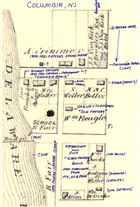2001.000.001.jpg
2001.000.001.jpg
Columbia
Columbia was first seized and surveyed by John Scott of Rhode Island. For almost a century the land changed hands often, and was finally purchased by Francis Myerhoff. He and his followers continued to settle the land.
The town was originally called Kirkbride's from the fact
that Joseph Kirkbride owned a large tract of land here. He was not one of the settlers. He eventually sold the land. It is widely believed that Columbia was eventually named after Christopher Columbus.
When Myerhoff purchased the land he resurveyed it, and divided it into 300 lots. He then sold these to merchant s such as Johnson and Schafer, who ran a store in 1817. Abram Pisch ran a grocery store, along with George Sessenburg who build and operated a hotel, and Mr. Liliendohals who started a silkworm business. He planted mulberry trees so that the silkworms could
eat the leaves. There are still some of these trees growing
i n the area today.
Columbia is situated on the Delaware River at the mouth of the Paulinskill, opposite Portland, Pennsylvania. It was originally connected to Portland by a substantial covered wooden bridge, which was the only one of its kind to withstand the flood of 1906. It was 796 feet long, having four spans of about 200 feet each, and had a passageway of eighteen feet wide. It was used extensively by automobiles , and was a toll bridge. It was bought in 1926 by a state of Pennsylvania and New Jersey and became a free bridge. The wooden bridge was destroyed by the flood of 1955 caused by Hurricane Diane. It was replaced by a footbridge , which remains today.
By 1813 Columbia had become a busy town. There was a ferry house, where people could cross the river . There was also a tavern, a store, four hotels, a sawmill, a grainary for storing farmers grain, a blacksmith, a post office, and an eight- sided school near the river.
Mr. Myerhoof's glass factory had become quite famous. He had learned the trade back in Germany, where he came from. It was done by blowing through a tube into hot glass until the glass would blow up like a balloon. It was then shaped by the glass blower into bottles, or whatever they wanted. When the glass cooled, it kept that shape.
The sand used in this glass making had to be brought from Sand Point, twelve miles away in the most northern part of Hardwick Township. Sand was also brought up the Delaware River in boats from Philadelphia.
The factory was a large building with about 30 people
working there. Many people would come from miles away to watch the glass blowing.
After 12 years, Francis Myerhoff fell into hard times, and
the factory was sold. The new owners also had bad luck, and in 1830 the factory was closed for good. Later, the factory burned to the ground.
When the factory closed, Columbia was no longer the
important town it once was.
